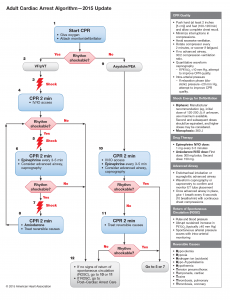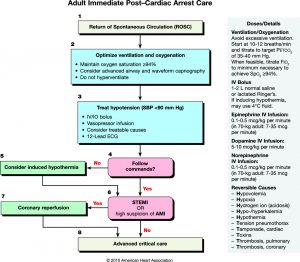Links:
Shockable Rhythm:
Temperature Management After Cardiac Arrest
Non-shockable Rhythm:
Targeted Temperature Management for Cardiac Arrest with Nonshockable Rhythm
Targeted Temperature Management
GOAL CEREBRAL PERFORMANCE CATEGORY 1 or 2
Inclusion Criteria (all of the following)
- Patient > 18 years old
- Comatose
- ROSC after out of hospital or in hospital VF/VT arrest (may consider in PEA/asystole)
Exclusion Criteria
- Intracranial hemorrhage
- Bleeding diathesis
- Hypotension refractory to multiple vasopressors
- Severe sepsis
- Pregnancy
Protocol
- Each hospital has a therapeutic hypothermia protocol
- TARGET of 36°C (previously 33°C)
- 4 phases –initiation, maintenance, rewarming, and normo-thermia. TH should be initiated immediately after ROSC, with rewarming started 24 hours after target temperature is obtained
- Avoid sedation, if necessary to finish cooling protocol, attempt use of propofol
- Common issues of cooling to 33 not particularly problematic when cooling to 36 (shivering, hyperglycemia, hypokalemia)
- Rewarming is conducted at rate 0.25 C per hour to goal temperature 37 C
Prognosis in Cardiac Arrest
- Must delay neuro assessment for neurologic prognosis ~ 72 hours after return to normothermia
- Clinical signs that carry poor prognosis (if the first three are absent at 72h post-normothermia, 100% predictive of poor outcome)
- Lack of pupillary response
- Lack of corneal reflex
- Absence of motor response except extensor Myoclonic status epilepticus
- SSEPs measurement (somatosensory evoked potentials) response is most accurate predictor of poor outcome in anoxic brain injury
- Electrical stimulus of the median nerve (at the wrist). Nerve action travels up sensory and motor fibers with arcs through the spinal cord and into the brainstem and finally the thalamus (N18). After traversing the internal capsule the N20 peak is recorded over the somatosensory cortex contralateral to the wrist stimulated.
- Absence of this by 72 hours has a PPV of 100% for poor outcome
- Labs- neuron specific enolase > 33 ug/L


